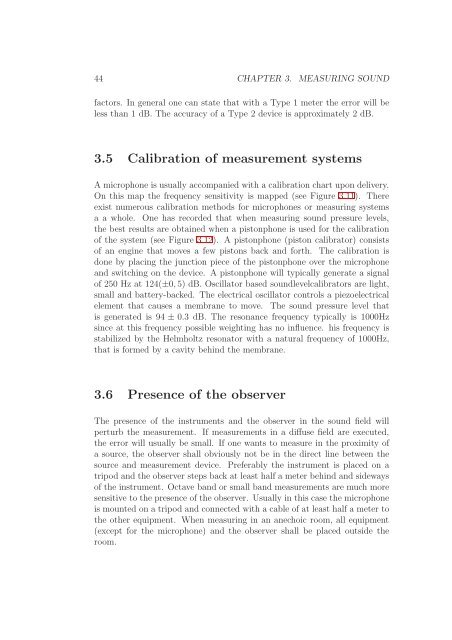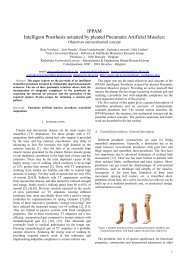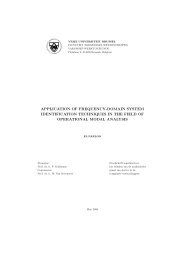VRIJE UNIVERSITEIT BRUSSEL Acoustics - the Dept. of ...
VRIJE UNIVERSITEIT BRUSSEL Acoustics - the Dept. of ...
VRIJE UNIVERSITEIT BRUSSEL Acoustics - the Dept. of ...
Create successful ePaper yourself
Turn your PDF publications into a flip-book with our unique Google optimized e-Paper software.
44 CHAPTER 3. MEASURING SOUNDfactors. In general one can state that with a Type 1 meter <strong>the</strong> error will beless than 1 dB. The accuracy <strong>of</strong> a Type 2 device is approximately 2 dB.3.5 Calibration <strong>of</strong> measurement systemsA microphone is usually accompanied with a calibration chart upon delivery.On this map <strong>the</strong> frequency sensitivity is mapped (see Figure 3.11). Thereexist numerous calibration methods for microphones or measuring systemsa a whole. One has recorded that when measuring sound pressure levels,<strong>the</strong> best results are obtained when a pistonphone is used for <strong>the</strong> calibration<strong>of</strong> <strong>the</strong> system (see Figure 3.12). A pistonphone (piston calibrator) consists<strong>of</strong> an engine that moves a few pistons back and forth. The calibration isdone by placing <strong>the</strong> junction piece <strong>of</strong> <strong>the</strong> pistonphone over <strong>the</strong> microphoneand switching on <strong>the</strong> device. A pistonphone will typically generate a signal<strong>of</strong> 250 Hz at 124(±0,5) dB. Oscillator based soundlevelcalibrators are light,small and battery-backed. The electrical oscillator controls a piezoelectricalelement that causes a membrane to move. The sound pressure level thatis generated is 94 ± 0.3 dB. The resonance frequency typically is 1000Hzsince at this frequency possible weighting has no influence. his frequency isstabilized by <strong>the</strong> Helmholtz resonator with a natural frequency <strong>of</strong> 1000Hz,that is formed by a cavity behind <strong>the</strong> membrane.3.6 Presence <strong>of</strong> <strong>the</strong> observerThe presence <strong>of</strong> <strong>the</strong> instruments and <strong>the</strong> observer in <strong>the</strong> sound field willperturb <strong>the</strong> measurement. If measurements in a diffuse field are executed,<strong>the</strong> error will usually be small. If one wants to measure in <strong>the</strong> proximity <strong>of</strong>a source, <strong>the</strong> observer shall obviously not be in <strong>the</strong> direct line between <strong>the</strong>source and measurement device. Preferably <strong>the</strong> instrument is placed on atripod and <strong>the</strong> observer steps back at least half a meter behind and sideways<strong>of</strong> <strong>the</strong> instrument. Octave band or small band measurements are much moresensitive to <strong>the</strong> presence <strong>of</strong> <strong>the</strong> observer. Usually in this case <strong>the</strong> microphoneis mounted on a tripod and connected with a cable <strong>of</strong> at least half a meter to<strong>the</strong> o<strong>the</strong>r equipment. When measuring in an anechoic room, all equipment(except for <strong>the</strong> microphone) and <strong>the</strong> observer shall be placed outside <strong>the</strong>room.
















